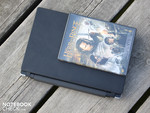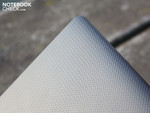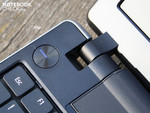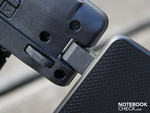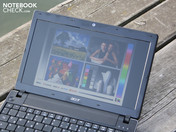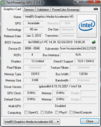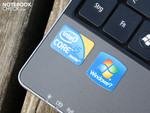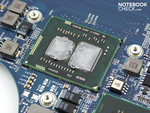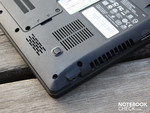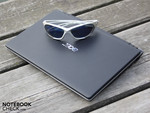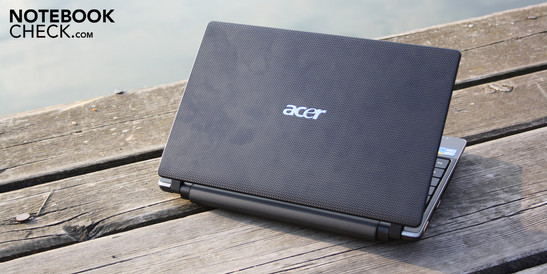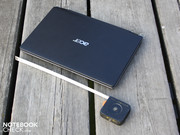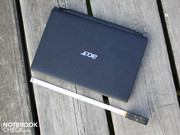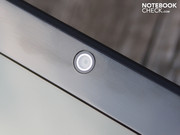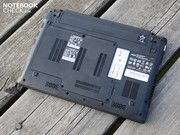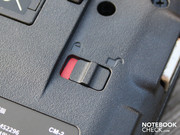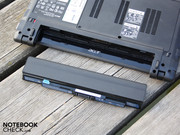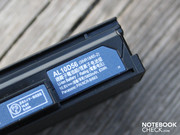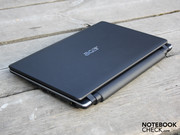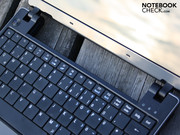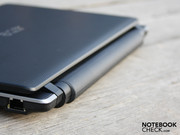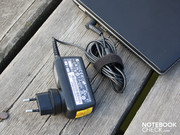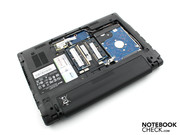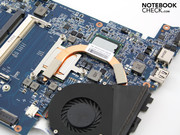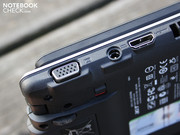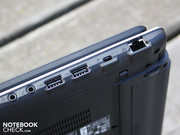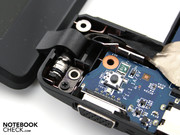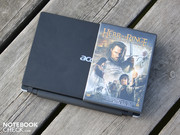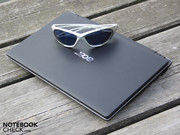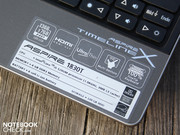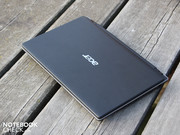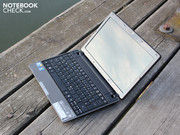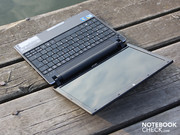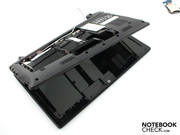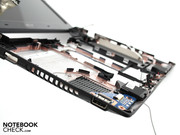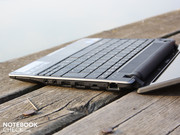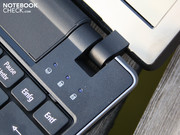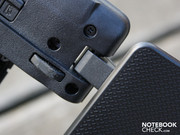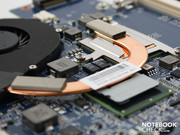Review Acer Aspire 1830T Subnotebook

Up until now, ultra mobile computing has had two meanings for the consumer. Either the customer turns to an Intel Atom. That doesn't cost 350 euro, but the device is quickly overtaxed even by the simplest tasks. Or the customer saves a bit longer and buys an 11.6 to 14 incher with Intel CULV (SU7300, SU4100 etc.) or AMD's Athlon & Turion II counterparts for 450 to 800 euro.
Those who then decide against the weak netbook and for the less weak ULV subnotebook will likely still not be satisfied. Chums with a Core i3 or Core i5 laptops simply work faster and boast with their processor benchmarks. That causes envy and furtive glances are taken at the faster but also more expensive ultra low voltage CPUs. These are Intel's SL9400, SU9600 or U7700 processors. But, unfortunately, they only work in high-priced devices, whereby an HP EliteBook 2530p is one of the most inexpensive at 1100 euro.
Thus, it's surprising that the ULV alternative of fast Core i5 processors is found so soon after the processor's market launch in a consumer subnotebook for 800 euro. The Core i5-520UM has all performance qualities of its bigger brother with 2 x 1.06 GHz. Does Turbo Boost and hyperthreading make the 520UM faster than the mentioned Premium ULV CPUs a la Intel SLxxxx, SUxxxx and Uxxxx?
Case
Before we get down to business, we'll deal with the trappings. The 11.6 incher is in a flat case that reminds strongly of an Aspire One 752. If you look at the single details and features of work surface and base plate, you'll find many differences, though. Edges, feet, battery latch or the wrist-rest bezel - all of that differs strongly from the Aspire One 752's chassis.
On the whole, the case is feasibly solid. We can only bend it to an extent with both hands. The brushed plastic wrist-rest (looks like aluminum) can't be dent anywhere. The base plate proves to be not as solid. Simple pressure on the vents forces it to yield. The slightly protruding battery that, however, sits firmly in its latch is praiseworthy.
Whilst Acer netbooks always provide for smeary surfaces with a high-gloss lid, the Timeline X presents itself as a suitable worker. A pleasant, matt, haptically patterned surface almost rebuffs fingerprints completely. Together with the matt plastic work area, the 1830T makes a sober, insensitive impression. But then again, the lid isn't that stable, either. The center's surface yields considerably under light pressure.
The hinges allow for a wide opening angle of almost 170 degrees. That ought to please users who want to use their mini-computer while lying around or in very tight spaces (bus, plane, etc). The hinges don't have a clear stop in their final position and let the lid teeter considerably there. The closing force, which keeps the lid and base unit together without a latch, isn't very defined. The lid opens itself three centimeters when turned upside down.
Connectivity
The Timeline X is equipped like the Aspire One 752 subnotebook, apart from details like Bluetooth and SPDIF. Aside from the three standard USB 2.0 ports, we find HDMI and Bluetooth 2.1+EDR. The TV set or an external TFT display fits on the HDMI and VGA port (HDMI for audio transmission). This connection makes a loss-free transmission to a home stereo system possible. Not quite as loss-free is the 0.3 MP webcam with a weak resolution. The Crystal Eye camera in the display bezel shoots pictures with 640x480 pixels.
The other connections are standard and could also be found on a netbook in this array. The Ethernet slot (RJ45) seems to be mandatory, although most users don't even know what such a cable looks like any more due to WLAN. If you transfer vast amounts of data over your home network, you'll quickly come to appreciate the Atheros AR8151 PCI-E gigabit adapter. The network card sends data packages in the fastest standard. If you rather radio, you can do it with draft-n.
Input Devices
Keyboard
We didn't like the inexpressive keyboard. The feedback during typing and when the hands glide over the keys is spongy and homologous. The reason for that is an unclear pressure point and vague stroke. The stroke gets even vaguer in the left key area because of the yielding base. The very tight key gaps additionally make things difficult for the typist. Because the keys are absolutely plane and not concave, there is almost no haptical differentiation for the fingers. The keyboard's only positive feature is its generous layout with a clear lettering.
Touchpad
The multi-touchpad has been implemented in the wrist-rest and thus has a similar, lightly brushed plastic surface. A small, almost invisible, haptical bar has been applied on the pad's right and left to give the finger sense of location. There is a vertical scroll bar along the right delimitation marked in the same way.
Operating proves to be accurate and the finger glides quickly. The inconsistent and partly too high pressure point of the mouse keys really annoys us. Depending on whether inner, outer or lower area is pressed - we always receive a different feedback. Also, there frequently isn't any click when the lower edge is hit.
Display
The 11.6 inch (29.46 cm) display (type N116B6-L02) from the Taiwanese monitor manufacturer, CMO, has a resolution of 1366x768 pixels. That is a very high resolution for an 11.6 incher. The clarity on the desktop is increased in opposition to a typical 10 inch resolution of 1024x600. Permanent working on the small display is possible due to HD Ready.
The screen, with a 16:9 aspect ratio, has not been AR coated. The glare type, which Acer calls CineCrystal, provides for contrasts somewhat richer in color, but for annoying reflections, too. Also, the measured contrast of 202:1 can't be described as a good contrast. Contrarily: black colors aren't deep black, and colors aren't very brilliant.
| |||||||||||||||||||||||||
Brightness Distribution: 91 %
Center on Battery: 212 cd/m²
Contrast: 202:1 (Black: 1.05 cd/m²)
The display's brightness adds a good average to the rating, but it can't be called bright, though. The average of the entire surface is 206 cd/m2. The LED lit screen distributes its brightness fairly well and evenly, indicated by an illumination of 91%. Battery mode doesn't dim the brightness, unless the user sets it accordingly in the energy savings options.
The user may like to spend some time in the sun in a warm summer. Already because the good battery life and small size just simply tempt to challenge the mobility. If you want to check your emails while drinking coffee, you'll soon be intimidated by reflections. The luminance isn't strong enough to effectively withstand the reflections. Especially in view of the glare type, a luminance beyond 250 cd/m2 would have been desirable. But this way, a use in sunlight has to be traded for at least a place in the shade.
The horizontal viewing angles are good. We recognize script well up to about a 50 degree deviation from the center. The colors first invert then. But the image already dims considerably at 25 degrees. If our view strays downwards, it looks even worse (vertical). Script can only be read well up to about 30 degrees. The brightness, however, already dims considerably starting at 10 degrees. When several pairs of eyes gather before the Aspire 1830T, the viewers in the upper position can hardly recognize anything. Colors are already intensely inverted at a 30 degree deviation upwards.
Performance
Core i5 makes notebook fans listen attentively. Until now, the CPUs in the standard versions of 520M or 430M were convincing in all situations. Turbo Boost for single-core applications and hyperthreading (HT) for multi-thread applications. Do we now face the full notebook power in a miniature size?
No. The energy saving ultra low voltage alternative of the Arrandale CPU with the name Core i5-520UM has the same performance features as the standard version, 520M, but the clock rate is considerably lower in the operating states.
The dual-corer clocks with 1.06 to 1.86 GHz (Turbo Boost). In comparison: i5-520M: 2.4 to 2.93 GHz. The maximum thermal design power is 18 watts (TDP). The 520UM can compute with four threads simultaneously and thus accelerates multi-core applications tremendously. Hyperthreading provides every physical core with a virtual core. The Core 2 CULV/ULV computing cores (SU9400, SL9400, etc.) don't have this feature.
The integration of memory controller and Intel HD Graphics in the processor bundle belongs to the new Core i5 CPU's standards. A 2.5 inch Hitachi HDD with 320 GB and 5400 rpm is used as the hard disk. Also, a fast DDR3 RAM from Hynix collaborates with the GS45 chipset and the processor (two modules with 2048 MB each).
Is 1.86 GHz in Turbo Boost enough to maintain a befitting laptop performance? If you are thinking of at least the Core i3, the answer is no. The i5-520UM processor can't surpass the i3-330M (2.16 GHz, dual-core without Turbo Boost) in the synthetic processor benchmarks.
The i5-520UM achieves 4179 points in the Cinebench R10 Multi (64bit) benchmark with all available threads (HT: 2 cores + 2 virtual cores). This is far below the 6500 points that a Core i3-330M (2.16 GHz) reaches. The namesake 520M (2.4 GHz) reaches a comparatively colossal 8000 points.
The Aspire 1830T achieves 2435 points in computing with one core (Cinebench R10 Single 64 Bit). The Core i3-330M achieves 2850 points; an i5-520M reaches an average of 3700 points. It is interesting that an overclocked 520UM achieves 3083 points and thus can match the i3-330M. See Asus PL30JT.
Does that sound like a clear defeat? No, because only a comparison with ULV processors would be fair. The 520UM can score here (Cinebench R10 64 Bit). It pockets a SU7300 (1.600/3.050; Single/Multi), just like a SU9400 (1.700/3.260; Single/Multi). The Core i5 ULV (2.13GHz) only can't hold a candle to the high clocking Core 2 Duo SL9600 (2.726/4.815; Single/Multi).
| PCMark 05 Standard | 3940 points | |
| PCMark Vantage Result | 3950 points | |
Help | ||
The CPU computes on a good subnotebook level. Will the system performance also prove to be at this level? PCMark Vantage finishes with 3950 points. This score is a bit below that of Core i3-330M systems (about 4300 points without dedicated graphics).
A look at systems with a Core 2 Duo SU7300, an often used CULV processor, gives reason for joy. These systems only reach 2700 to 3000 points (without dedicated graphics). Even systems of the upper subnotebook category with SL9600 (2.13 GHz) are clearly defeated with 3095 points (Lenovo ThinkPad X200t). Because the hard disks haven't changed, the performance bonus in the Aspire 1830T is solely due to the i5-520UM (hyperthreading) and the Intel HD Graphics.
| 3DMark 05 Standard | 1957 points | |
| 3DMark 06 Standard Score | 1113 points | |
Help | ||
The Hitachi hard disk (type HTS545032B9A300), with a gross capacity of 320 GB, works with the usual 5400 rpm. It's a common 2.5 notebook HDD, not a 1.8 inch. HDTune determines an average rate of 53 megabyte per second in sequential read. This data throughput is below the average of comparable 2.5 inch hard disks. The Hitachi disk contributes to the subnotebook's system performance with a fairly low HDD score in PCMark Vantage. The SATA II hard disk is only audible with great attentive effort during operation.
Emissions
System Noise
Something as small and light as the 1359 gram 1830T should also ideally remain nice and quiet. That applies to the smallest Timeline X. Internet, mail and office - the fan rotates with 30.9 to 33.3 dB(A). The fan only throttles to the lowest level without any load. When the Core i5-520UM is put under load by our processor benchmarks, the level increases to an audible 38.3 dB(A). It doesn't matter if 3DMark2006 runs alone or in combination with Prime95 (CPU benchmark). The noise level stays constant.
Noise level
| Idle |
| 30.9 / 30.9 / 33.3 dB(A) |
| HDD |
| 31.2 dB(A) |
| Load |
| 38.3 / 38.3 dB(A) |
 | ||
30 dB silent 40 dB(A) audible 50 dB(A) loud |
||
min: | ||
Temperature
Aspire 1830T, a small heater? This anxiety wasn't confirmed. The surface temperatures stay within a green field. The upper side's average was 30.4 degrees. In regards to the base plate, use on the lap is saved with 31.5 degrees. The measurements were assessed in idle. Those who surf through the web, load word files and occasionally pack a Zip file in real-life scenarios should reckon with an increased temperature of about two degrees.
We only got the 11.6 incher really hot under constant load induced by a stress test made up of Prime95 and Furmark. Then the base plate reached almost 45 degrees in the air outlet's vicinity. That sounds alarming, but it's only reached selectively. The average of 36 degrees under load is lower.
The copper heatpipe and heat exchanger do a great job. The Core i5-520UM didn't heat up over 73 degrees Celsius during the two hour stress test. The normal temperature in less demanding office use is 50 degrees.
(+) The maximum temperature on the upper side is 37.7 °C / 100 F, compared to the average of 35.9 °C / 97 F, ranging from 21.4 to 59 °C for the class Subnotebook.
(±) The bottom heats up to a maximum of 44.4 °C / 112 F, compared to the average of 39.3 °C / 103 F
(+) In idle usage, the average temperature for the upper side is 30.4 °C / 87 F, compared to the device average of 30.8 °C / 87 F.
(+) The palmrests and touchpad are reaching skin temperature as a maximum (33.1 °C / 91.6 F) and are therefore not hot.
(-) The average temperature of the palmrest area of similar devices was 28.2 °C / 82.8 F (-4.9 °C / -8.8 F).
Loudspeakers
Our demands on the 11.6 incher weren't particularly high in terms of acoustics. Both stereo loudspeakers sounding from underneath the wrist-rest can fulfill the minimum level of quality. You shouldn't expect more from a treble-prone sound, anyway. We would recommend disabling the Space Expander in the loudspeaker's properties. It provides for an unnatural reverberation in music. At least the level can be turned up to full without the little membranes scratching. That's enough to fill a small room with sound.
Connecting an external sound system over a 3.5 millimeter jack, respectively over the combined SPDIF, is advantageous for music fans. We tried the analog-out with two active Yamaha speakers (YST-M20SDP). The volume tethered to the notebook can be turned up very high. A simple audio test didn't emit static at a low output level.
Battery Life
The Aspire 1830T can fulfill the expectations on a subnotebook aligned for performance in battery life. The 7:30 hours of an Asus UL30A (SU7300, WLAN) isn't replicated, but five hours aren't bad, either. The 11.6 incher achieves almost five hours (287 minutes) during WLAN surfing and at a brightness of 100 cd/m2. We can watch a movie from the hard disk for just as long. The AVI movie runs 4:46 hours.
The Aspire 1830T stops at 5:45 hours (345 minutes) without load - that is idle with disabled wireless and lowest brightness. That's the maximum possible runtime. The battery is drained within the shortest time if a constant CPU load of 100 percent is generated (BatteryEater Classic, energy mode: high performance). However, that still means a good 2:51 hours under load in the 11.6 incher's case.
Comparably strong subnotebook opponents with a Core 2 Duo SP9400 (2.4 GHz, Dell Latitude E4300, 56Wh) don't last much longer with a similar battery capacity. We determined 4:40 minutes for the 13.3 incher in the WLAN test at the time. The weaker SU9400 (1.4 GHz, Acer TravelMate 8471-944G32Mn) can boost a 14.1 incher to a proud 7:30 hours (WLAN).
The recently reviewed Asus PL30JT with the same Core i5-520UM isn't comparable because of the stronger 84 watt hour battery and 13.3 inches (WLAN 6:28 hours).
Fitting to the good battery life, we've measured a low energy requirement of 6.5 watts in idle and 26 watts under load by 3DMark2006. Depending on the energy profile, brightness and wireless modules' activity, the idle power consumption can climb to 10.7 watts. In comparison to standard notebooks, those are very low rates. Normal Core i3 and i5 systems have a minimum idle power consumption of 12 to 17 watts. Naturally, the small display surface that has to be lit contributes to the Aspire 1830's low power consumption.
The effective power increases up to 30.3 watts when the 11.6 incher has to give everything (stress test). Thus, 12 watts are added by HDD, light, wireless modules and chipset to a CPU with an 18 watt TDP. The battery was removed for the measurements. The 40 watt plug-in adapter has an apt size for this energy requirement.
| Off / Standby | |
| Idle | |
| Load |
|
Key:
min: | |
Verdict
With the Core i5-520UM, the manufacturer, Acer, puts computing power into the 11.6 incher, Aspire TimelineX 1830T, which was only known from expensive subnotebooks with Core 2 Duo SL/SP processors until now. These high-performance ULV subnotebooks are only available in the expensive business division. An absolute novelty in the price range of less than 1000 euro is the 11.6 inch test device's performance. There aren't any alternatives with an equally strong performance in this size.
Despite the apparently low 1.06 GHz, the computing performance can surpass that of older Core 2 Duo CULV processors due to hyperthreading (multi-core). The 520UM can't quite keep up with the aforementioned SL/SP processors from Intel, due to the low turbo rate of 1.86 GHz (single-core).
The battery life of almost five hours (WLAN surfing, movie from the hard disk) is adequate. The weight of 1359 grams (incl. 5800 mAh battery) plus the light 191 gram adapter can impress the tester just as much as the reasonable waste heat and low system noise in office mode.
So much praise, but not a "Very Good" anyway? As good as the 11.6 incher is in performance and battery life may be, the input devices are at most satisfactory. Spongy typing feel, yielding key bed and inconsistent mouse keys - that results in point deductions for the input devices. Other criticism concerns the only average bright glare type display. A genuine mobility product has to be brighter and AR-coated.




